3M Touch was mainly highlighting that it can support higher quality and more differentiated object recognition using touch tables. The company told us that it currently has no plan to try to extend its PCap technology beyond the 65″ level that it currently reaches as volumes fall away rapidly above that and the company is interested in volume markets.
AG Neovo is gradually developing complete solutions rather than just monitors and hardware. The company showed us how it has developed a technology app that it calls ‘NetMouse’ that puts a QR code on a display. If a user connects using the code, then the display can be controlled using the touch screen on the portable device. The company sees applications such as allowing users looking at a display in the window of a real estate agent when closed, allowing the user to access details on the in-window display.
The company also had some new display technologies and was showing a 75″ UltraHD display that has four inputs and can be driven as though it was four FullHD displays.
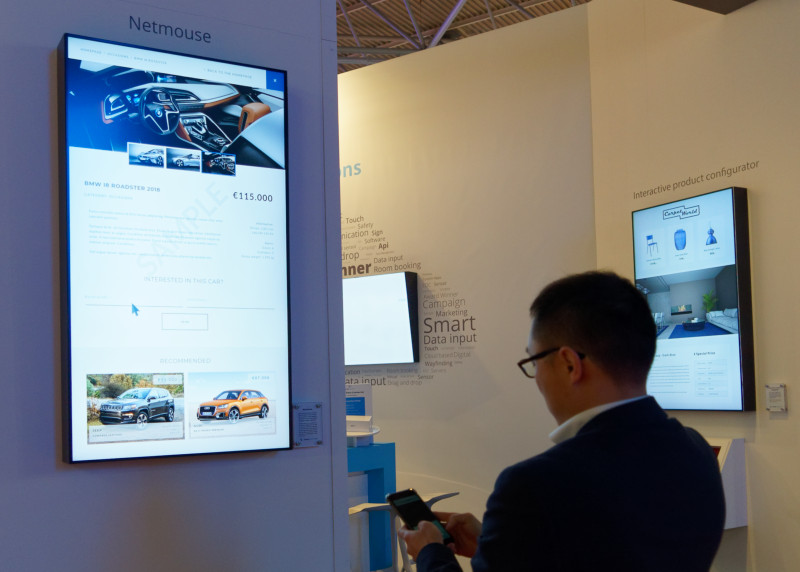 AG Neovo showed how the NetMouse software could be used to control an in-store display from a portable device. Image:Meko
AG Neovo showed how the NetMouse software could be used to control an in-store display from a portable device. Image:Meko
Glass company, AGC, was at the show to demonstrate its anti-sparkle anti-glare coatings which can offer good quality visual performance, even with high resolutions that would usually cause sparkle (a kind of ‘sugary’ look – Man. Ed.) using traditional anti-glare approaches. The company told us that it works well up to 500 ppi.
The company has also been working on the surface of its glass to improve the feel for touch applications and has infrared transparent glass for technologies such as those from FlatFrog and RAPT.
The company also had its Falcon glass which is stronger than regular soda lime glass, but is much cheaper than Dragontail/Sensation/Gorilla Glass. The company told us that it is being used in optically bonded displays and by Planar/Leyard as well as in other applications such as automotive interiors.
AGC has boosted its facilities in Europe, especially in the Czech Republic which means it can now be more responsive in supply.
 AGC’s non sparkle glass allows etched anti-glare treatments with high res displays. Image:Meko
AGC’s non sparkle glass allows etched anti-glare treatments with high res displays. Image:Meko
It’s a while since we saw French autostereo and tracked view 3D developer, Alioscopy. The company was sharing a booth with a partner at the show and had a demonstration of tracked stereo view operation as well as the autostereo technology, which had 12 views. The tracked demonstration was very good although the ‘between zones’ effect was apparent on the autostereo version. The higher resolution displays that are becoming available are helping the company to improve the user experience. In terms of applications, the company told us that it is working on 3D endoscopy. Although a member of the 3IT in Berlin, the company was not aware of the project being undertaken on that topic in Germany. (3IT2 Doctors Still Keen on 3D)
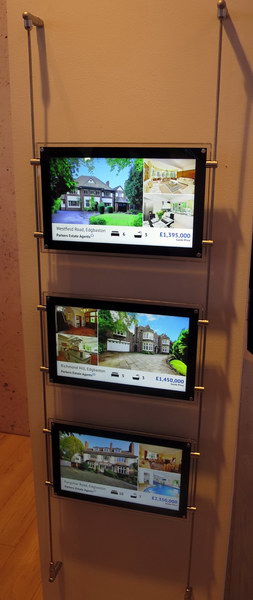 Allsee rod display with three screens in a real estate application at ISE. (Credit: M. Brennesholtz)
Allsee rod display with three screens in a real estate application at ISE. (Credit: M. Brennesholtz)
Allsee Technologies was showing two new digital signage displays, a 28” LCD unit with Android built in and a rod display, as shown in the photo. The two vertical rods supply both mechanical support and power to the 15” LCD displays. Communication with the Android-equipped displays is via Wi-Fi. The rod display is expected to launch in mid-July.
We reported on Avocor from BETT (Avocor Moves to Optical Bonding). At ISE, the emphasis was on corporate communications rather than education. There were prototypes of the new F Series displays which will have 20 touches and will be available later this year. The 65″, 75″ and 86″ units all support the Intel Unite collaboration platform.
Baanto was showing the latest variations on its ShadowSense Pro technology, which uses the same hardware as its previous versions, but is implemented in a firmware upgrade. The company also said that it is developing a new hardware version that is 28% thinner than the previous version and uses more sensors. The company also told us that it has moved the optical plane that it can detect nearer to the surface of the glass which makes the pen up/pen down control more precise. The new version will be available around the end of Q1 or early Q2 with Ricoh and NEC. Baanto has been working over the last couple of years to develop its support of video walls and is working with NEC and Panasonic. The company has developed a new ShadowSense Slim technology for displays from 10″ to 27″.
Brightsign was previewing its Series 4 range which will feature support for Dolby Vision and HDR10+. The company told us that the demand for this was driven by ‘big box’ retailers which are looking for ways to demonstrate HDR TVs – so far they have had to try to use Blu-ray players and other devices, but this is not very satisfactory. (We were surprised that the company is not supporting HLG, but this could be because of its US heritage. We explained why they might want it in Europe and so you may see it in future players! Man. Ed.)
The company also told that its Brightsign built-in module is now getting some traction with companies making tablet-like kiosks for retail applications. One of the suppliers is Outform which has integrated a Brightsign H123 player into its iDisplay 10.1″ Tablet with a 1280 x 800 300 cd/m² display and based on an RK3188 quad core processor.
 Brightside’s Built in module – please excuse the poor focus! Image:Meko
Brightside’s Built in module – please excuse the poor focus! Image:Meko
Clevertouch was showing a new range of professional interactive displays that are planned for June in 55″, 65″, 70″ and 86″ sizes. The displays feature infrared touch and have an EMR pen-based (think Wacom) pressure sensitive system for recording Z values. The displays also have NFC for connectivity.
CTouch of the Netherlands was showing its Leddura 2Meet touch display in 75″. It is sold into commercial and educational applications. The company was showing how it has developed the software for room bookings and meetings. The sets have UltraHD panels and 65″ and 86″ are also available and they support 32 touch points. An unusual feature of the CTouch displays is that they feature very good audio, with stereo 40W speakers and sub-woofers from JBL. The displays also have JBL far-field microphones and they include both SoCs and OPS slots (so that Intel Unite could be supported). The displays automatically erase data at the end of meetings. The company was also highlighting its 2Share wireless sharing system.
Displax of Portugal was showing a new development which is a genuinely circular PCap touch screen that was demonstrated at the event using a rear-projection configuration. The company told us that it is not quite ready for mass production but has been developing the technology with driver maker, Synaptics.
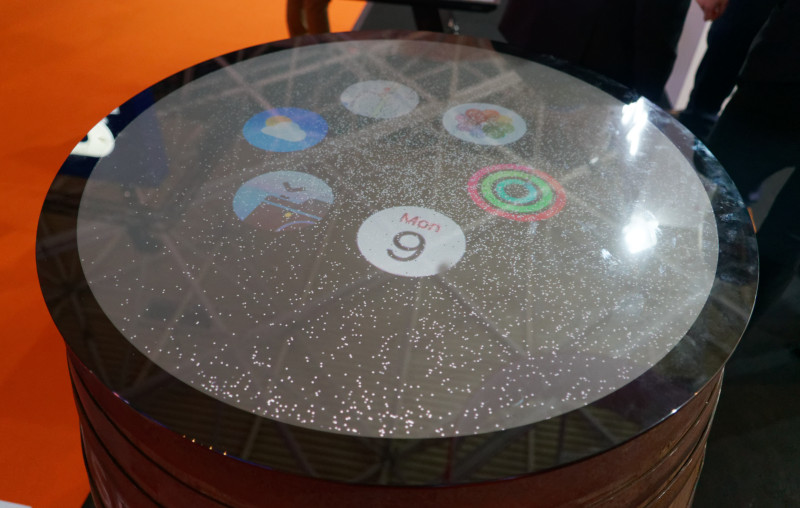 Displax showed a round PCap touch system using rear projection. Image:Meko
Displax showed a round PCap touch system using rear projection. Image:Meko
DVDO released details of its new collaboration tool before ISE (DVDO Tile Supports Five Users) and that was the highlight of its ISE presentation. Staff gave us a bit more information about the device, which is quite flexible, allowing up to five separate wireless video signals to be shown on the main display and allowing control from a mobile app (PC, Mac, iOS, Android). The device can work as a standalone adhoc network point or can be integrated into corporate networks. As well as supporting display via wireless, the box has five HDMI inputs, so can support any mix of wireless and wired devices. The box is shipping now at $1,199.
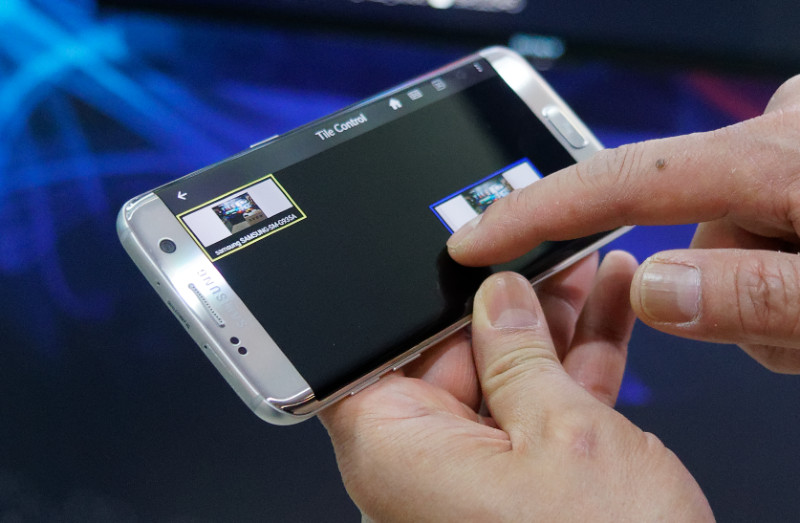 DVDO’s Control App supports PIP and up to five devices. Image:Meko
DVDO’s Control App supports PIP and up to five devices. Image:Meko
We reported on Hanshin Board from Bett and the company was also at ISE with a range of touch-enabled integrated Android-based systems in 15.6″, 21.5″, 23.6″ and 32″. The systems have PCap touch and are available immediately in the market.
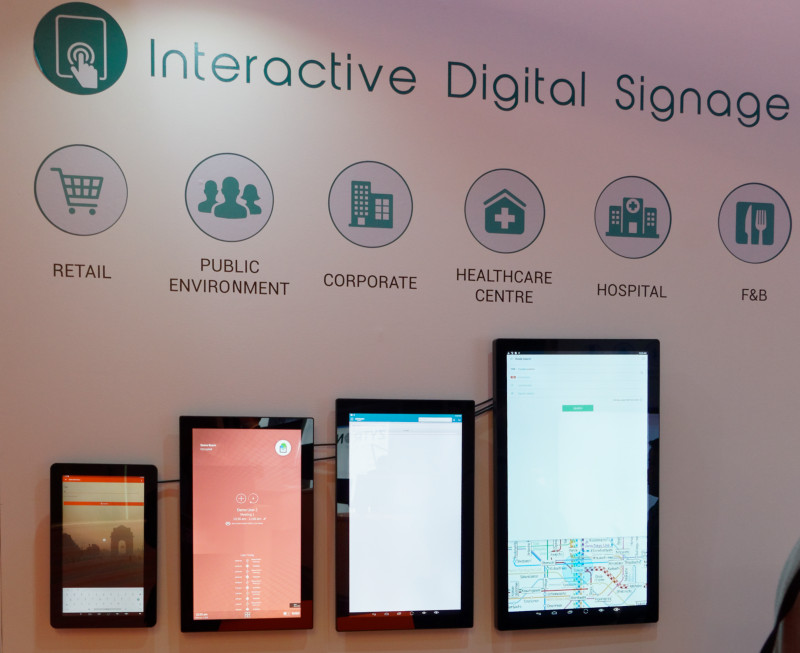 Hanshin board was showing these fully-contained Android systems in sizes up to 32″. Image:Meko
Hanshin board was showing these fully-contained Android systems in sizes up to 32″. Image:Meko
Iiyama had a new UltraHD series of monitors which go down to 49″ and have edge to edge glass PCap fronts. Resolution is UltraHD for that size and above and the displays are rated for 24/7 operation. The sizes are 32″, 42″, (both FullHD) 49″, 55″ and 65″. The monitors are described as ‘open frame’ but effectively are cased.
There is also a new 10″ TF1015MC 1280 x 800 PCap edge-to-edge glass front monitor with 500 cd/m². The range extends also through 15″, 21.5″ and 23.8″. An innovation from Iiyama is rubber surrounds that allow the closed monitor to be easily integrated into other systems. The company told us that the monitors are controllable by ethernet.
In the 34 series, Iiyama has replaced the existing DVI interfaces with HDMI and DisplayPort.
Iiyama told us that it has a new 40 series starting with a 55″ UltraHD display with an SoC to support Android and with support from Iiyama’s own CMS software. It will start to become available in April.
Finally, Iiyama has a new 98″ monitor coming in May.
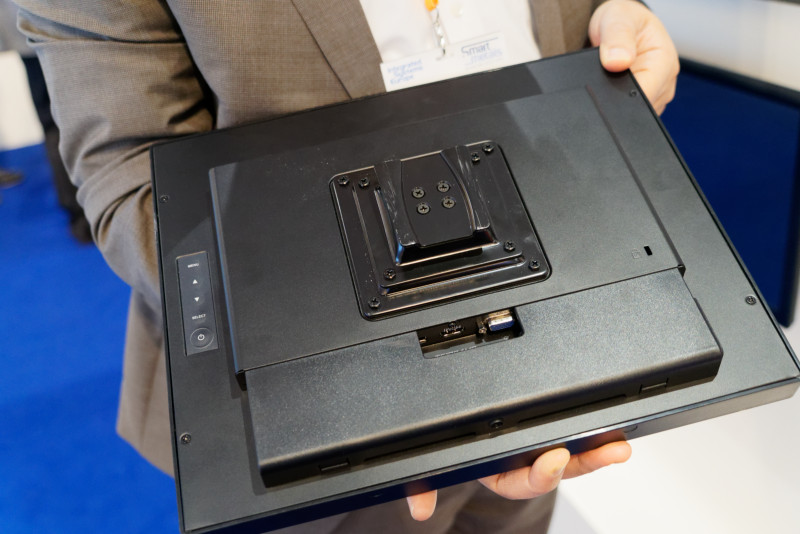 Iiyama describes its new monitors as ‘Open Frame’, but they are effectively cased units. Image:Meko
Iiyama describes its new monitors as ‘Open Frame’, but they are effectively cased units. Image:Meko
InFocus had a couple of new projectors at the show. The first that we looked at was the IN5359 ‘Ultrabright’ unit which uses a laser phosphor unit with 6,000 lumens of brightness and with an 8,000 lumen version later. Other details are still tba.
The INL146HDUST is an Ultra Short Throw chassis design that will be available in 1080P, 1280 x 800 and 1024 x 768 and which also uses laser phosphor light sources. Details will be released as the range starts to ship between now and March.
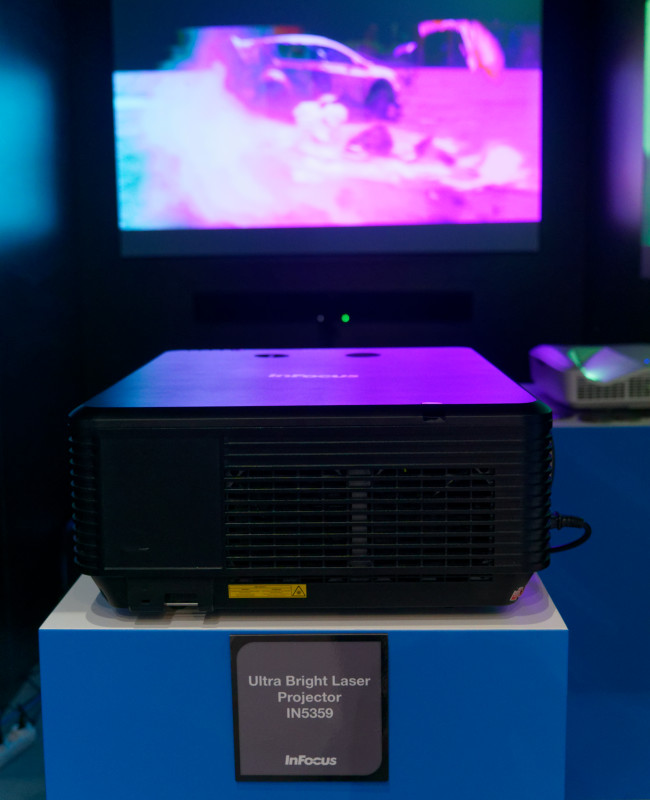
There was a new version of the Mondopad collaboration display which has been moved down now to 55″ and uses infrared touch and with an Android SoC as well as OPS for higher performance. The company also had a new 65″ PCap display and a 75″ display in the JTouch monitor range (INF75340eAG) with UltraHD resolution and infrared touch. It also integrates Android.
The company has also done a deal with Multitaction and the company can now supply the company’s high end collaboration systems in custom and standard configurations.
Inotouch of Korea was showing its PCap foil for touch enabling displays which is based on silver nanowire. The company targets the film at applications including industrial, education and DIDs. The range of sizes is from 7″ up to 65″ and the company can also supply glass substrates, but does not try to supply complete displays. At the show, the company was highlighting a new active pen, which did not use EMR, so needs batteries. Staff told us that the pen costs around $30.
Codec developer, Intopix, was mainly showing its technology being used for the compression of video prior to transmission over IP networks and had a demonstration of UltraHD resolution content being transmitted via standard 1Gbps and 10Gbps Ethernet. The Tico codec was being uses in one demo which meant low latency, but higher bandwidth and the company was also showing its JPEG2000 codec which compresses more, but has more latency and complexity.
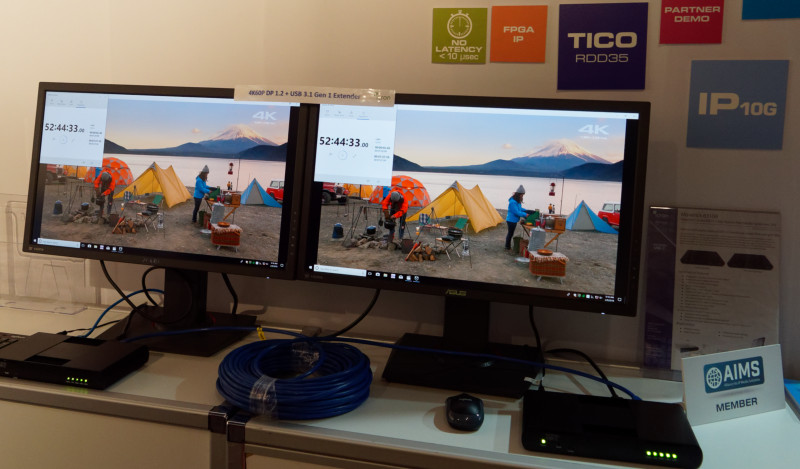 The light IntoPix Tico codec is very low latency. Image:Meko
The light IntoPix Tico codec is very low latency. Image:Meko
IRTouch is a supplier of touch technology to other companies (Dell, Iiyama, NEC and Vestel, among others and also works with UTouch on overlays) and is based in China, from where it has been supplying for 20 years. It can support displays from 10″ to 200″. It also has a version of its infrared technology that can be used outside and can be sealed to IP65 as an option.
At the show, the main news was of a new IR system that can be sealed with the glass and can work even if only 3 sides of the display are available for touch. It was also showing its developments with UTouch for video wall overlays, which can be supported up to 2m x 6m.
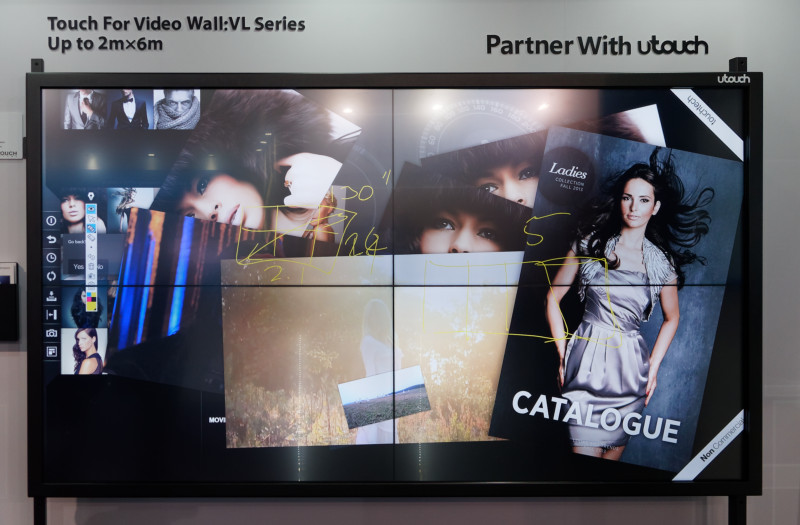 IRTouch can support video walls. Image:Meko
IRTouch can support video walls. Image:Meko
Kino-mo of the UK has been showing its rotating LED displays for some time and has recently seemed to have improved the synchronisation between different displays to make them look more seamless and we finally managed to get a good shot that shows the potential of the Hypervsn system. There is a spinning LED display at each intersection of the frame below. The display always attracts a lot of viewers at shows such as IFA, CES and ISE.
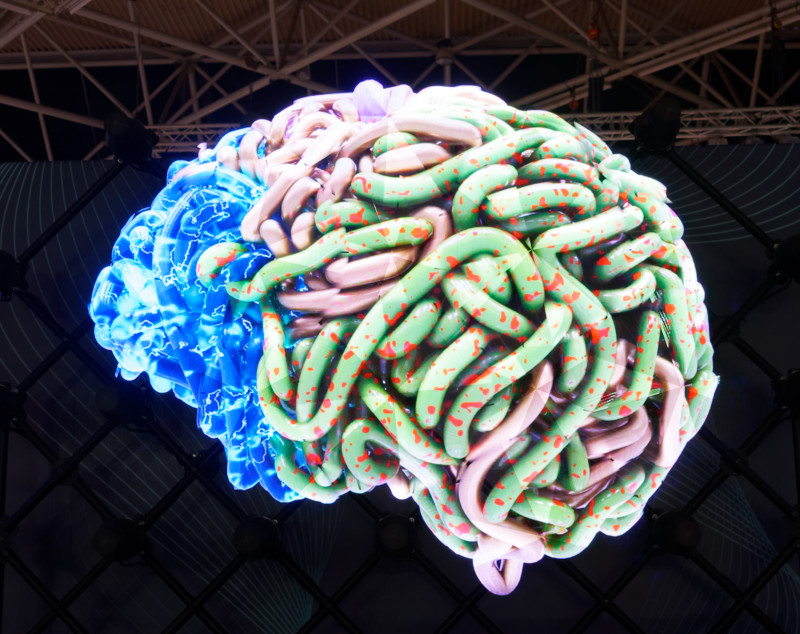 We finally got a good image of the Kino Mo Hypervsn rotating LED display! Image:Meko
We finally got a good image of the Kino Mo Hypervsn rotating LED display! Image:Meko
Shenzhen KTC Commercial Display Technology Co.,Ltd, otherwise known as KTC was showing a range of interactive LCDs but also had a 55″ OLED display.
Matrox was demonstrating its latest IP-based KVM technology which and run 4K P60 content with 4:4:4 sub-sampling over 1Gbps Ethernet. We were surprised that the system uses Matrox’s H.264 technology as we had assumed that latency would be too long for KVM use, but it felt very close to live and quality was very good, without noticeable artefacts. The technology will start to ship in Q2.
 Brightside’s Built in module. Image:Meko (excuse the focus!)
Brightside’s Built in module. Image:Meko (excuse the focus!)
Newline, based in Texas, but with facilities in Taiwan, is a maker of interactive large displays for commercial and educational use and we stopped by the booth as we heard that the company was showing its latest X9 technology which features direct bonding to minimise parallax errors, which greatly improves the experience of writing with a stylus on a display. It uses the FlatFrog InGlass technology (also in the X5, X6, X8 and X9 ranges). The firm has models in 65″, 75″ and 85″ (86″ later). The monitors have top and bottom cameras for conferencing and far-field microphones, so can directly be used for conferencing. They have an SOC for simple apps and an OPS slot for when more power is needed.
The company also has large displays using PCap technology in its X7 series (currently 70″). It is planning other sizes with PCap later. The challenge of PCap is the price of the system which is currently around €14,500.
Pallas continues to improve its LED-based technology for covering the bezels of LCD video wall displays. This time, the main change is an improvement in the corners, which were previously black, but now have an appropriate colour pattern.
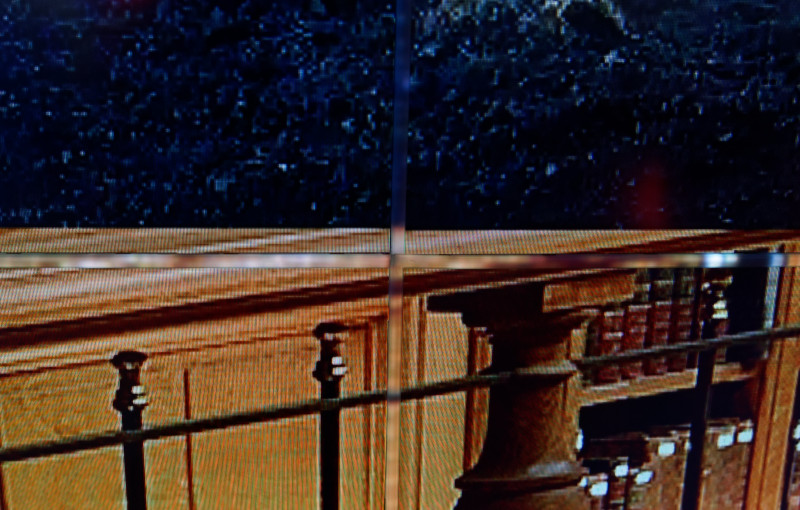 The Pallas latest version has better corner performance. Image:Meko
The Pallas latest version has better corner performance. Image:Meko
Pilkington/NSG is a glass maker that was showing three different types of glass, optimised for use in the kind of displays being shown at ISE. The first was a range of A/R coatings under the name of OptiView that are intended to be colour neutral and that can also be used in laminated glass.
The second glass is a special heat absorbing glass that can be and is being used to protect some outdoor digital signage to reduce the heat from the sun that gets into the display.
Finally, the company had a special touch-compatible mirror glass that is available in sizes up to 6m x 3m and made using chemical vapour deposition (CVD) technology. The company told us that it has developed the glass to try to be colour neutral.
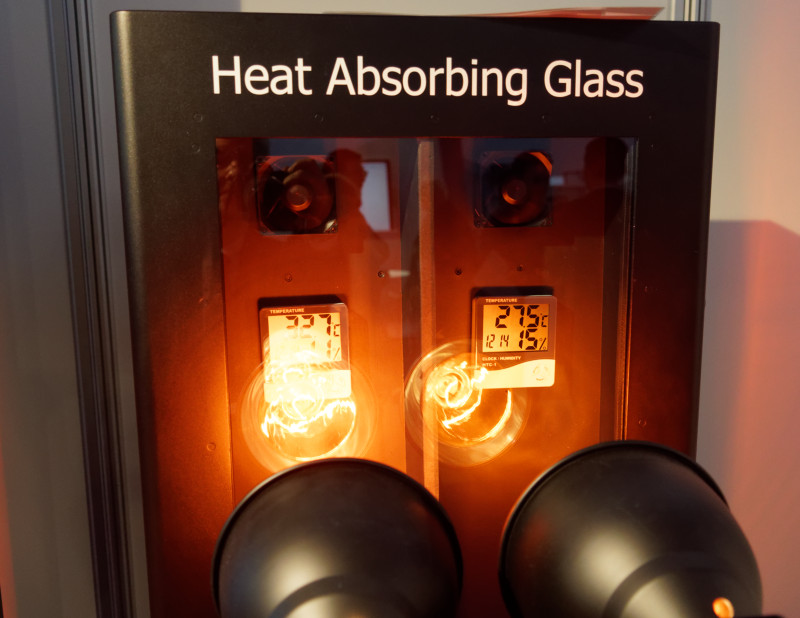 NSG Pilkington’s glass can reduce the heat from the sun in an outdoor application. Image:Meko
NSG Pilkington’s glass can reduce the heat from the sun in an outdoor application. Image:Meko
PQ Labs is one of the key suppliers of technology for infrared touch and we reported from Infocomm last year on its development of much smaller bezels for infrared and the new design has been widely adopted as we saw at BETT and at ISE. The G7 technology, which was reported then, also has options for use in difficult conditions such as in sunlight and outdoors.
PQ Labs is moving on to G8 of its technology which has been developed to be fitted to existing glass windows, for example in retail stores, into a touch display. The technology can now be used in glass with diagonals up to 70″ and can be used in sunlight.
The company was also showing how its infrared technology could be used for object recognition. Unlike most other systems, the technology does not need special tags on the bottom of objects, but depends on the shape and texture of the object.
Shandong Prosperous Star Optoelectronics (which calls itself JTX!) was established in 2014 to develop LED lighting and displays with a high level of vertical integration including its own design of LED flip chip. At the show it was demonstrating its 0.9mm to 1.9mm ‘mini LED’ devices. The company told us that its LED modules are particularly robust.
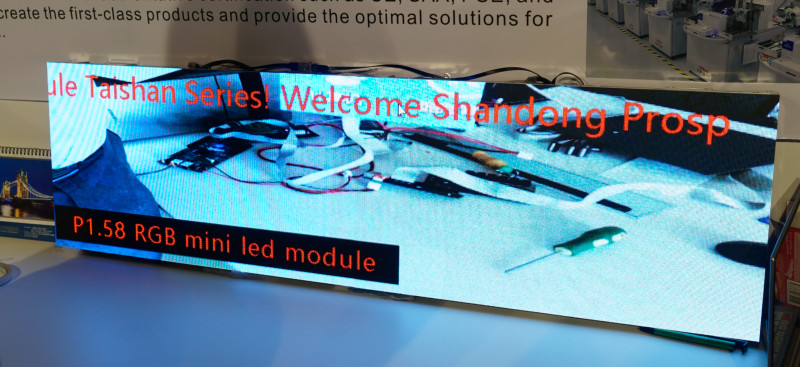 Shandong JTX told us that its mini-LEDs are also being used in backlights. Image:Meko
Shandong JTX told us that its mini-LEDs are also being used in backlights. Image:Meko
Foxconn’s Smart Technologies, like several other makers of interactive displays was at BETT a couple of weeks ago (Smart Responds to Lower Cost Demand). At ISE, the emphasis was on corporate communications and especially the 7000 Pro Series used with collaboration software rather than the Notebook software used in education.
SmartShelfStrip is a Korean start up that is developing LCD-based shelf edge labels that are completely self-contained, apart from the power source. The units are 23.6″ diagonal and have 1920 x 216 resolution and with 450 cd/m² of output. They are designed to be updated by Wi-fi and multiple labels can be synchronised for very eye catching displays in multiple shelf configurations. The labels can also be updated via a CMS or where this is not convenient, by USB. The firm aims to add touch functions ‘later’.
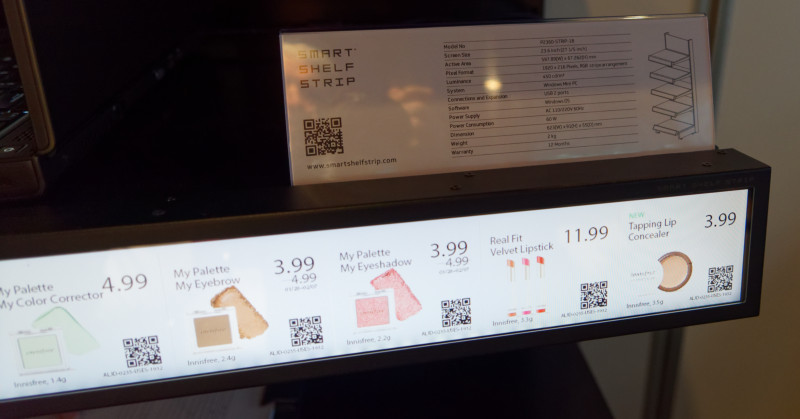
Sumacro Technology is from China and was showing its LED driver technology. The company said that its drivers has been used to go down to 0.9mm pitch, but 0.8mm ‘in the lab’ and up to around 4mm to 5mm. There are pin-connected and BGA packages available, as the BGA devices can be more compact, but need more layers in the circuit board, while the pin-connected chips can use a four layer board. The driver supports common cathode driving (the method used by Silicon Core alone, up to now). The method is said to be better for power consumption and the company also has a power saving technology that it calls Idle Stop (and seems similar to technology introduced by Macroblock a while ago). At the show, the company was highlighting the latest version of its driver, the SUM6082D,
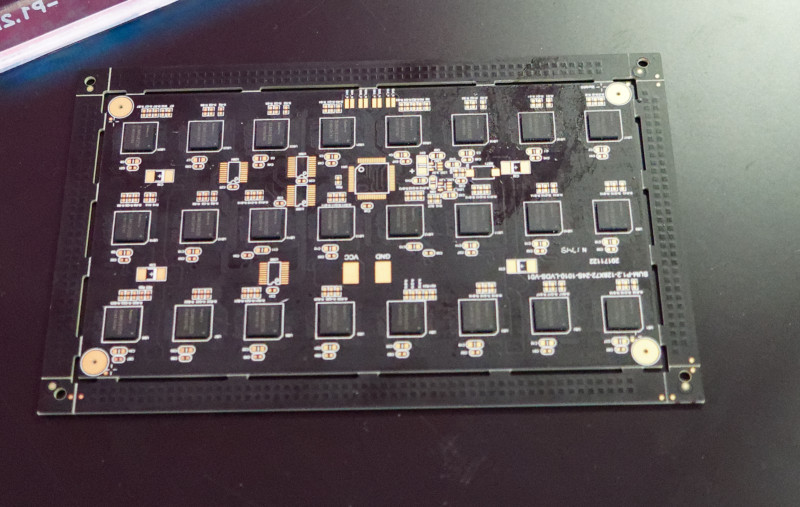 Sumacro showed its LED Driver chips which can support common cathode driving. Image:Meko
Sumacro showed its LED Driver chips which can support common cathode driving. Image:Meko 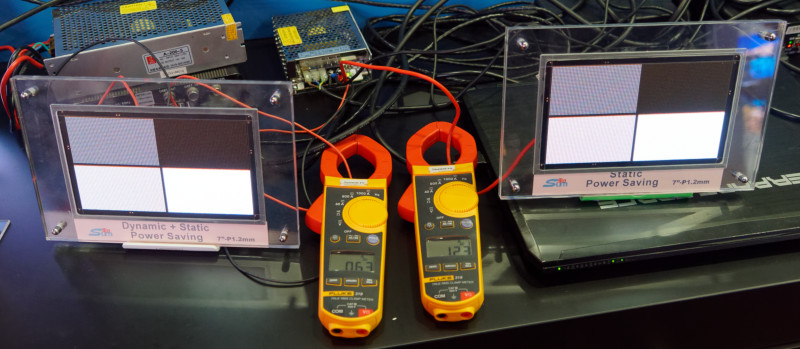 Sumacro showed its power saving drivers. Image:Meko
Sumacro showed its power saving drivers. Image:Meko
Triumph Board no longer goes to the BETT show to demo its interactive displays, but we caught up in Amsterdam. The company is doing particularly well these days in the US (where the educational display market is said to be going well at the moment, we heard in London). The company was showing a new range of 55″ to 98″ models which are all now UltraHD resolution, support 32 touches using infrared and have an OPS slot as well as an SoC running Android 5.0. The company also has a range of options and stands.
Userful is a supplier of software-based video wall management software that can support an ‘indefinite’ number of screens which can be arbitrarily arranged. Each display has to run a ‘zero client’ computing device which Userful supplies and which costs, the company told us, “in the range of $100” and which works using, we heard, ‘Internet over USB’ protocols. The displays supported are FullHD and the whole system can be managed and controlled using the Userful cloud management system. Userful can support video walls in rotated configurations. Image:Meko
Userful can support video walls in rotated configurations. Image:Meko
Vestel continues to develop its B2B business. At the show it had new larger sizes – in 75″, 86″ and 98″ with UltraHD, a quadcore SoC and OPS and which also are available in 400 cd/m² or 700 cd/m² brightness. (the same new sizes as added by Toshiba….. Man. Ed.). The PDU series is rated for 24/7 operation and can be fitted with an iR touch overlay.
The company also had new 49″ 55″ 1.8mm video wall monitors with OPS and support for internal scaling in arrays of up to 10 x 10 monitors. Brightness is from 450 to 700 cd/m² and the video wall monitors are rated for 24/7 use. Also at the show, the company was highlighting that it has hotel TVs including sets that support the traditional coax signal distribution techniques. It also has signage for retail and with brightness up to 2,500 cd/m². The company is still finalising its offer in narrow pitch LED, but will have a range of product in the future.
A new development for Vestel is the creation of a ‘Digital Boardroom Solution’ that integrates SAP software which allows access to KPIs and BI dashboards. The 65″ display uses an UltraHD panel with an infrared touch system and is rated for 16/7 use. Users can also connect to the display by wireless.
Xilinx was showing how its ASICs are being used by Ominitek to support the transmission of HDMI at up to 4K 60P and USB transfer over 1Gbps commercial ethernet. The technology uses the HEVC codec dedicated hardware for which is implemented in hardware in the Xilinx ASIC. Applications include the support of cameras for videoconferencing.
 Xilinx has integrated hardware for HEVC processing. Image:Meko
Xilinx has integrated hardware for HEVC processing. Image:Meko
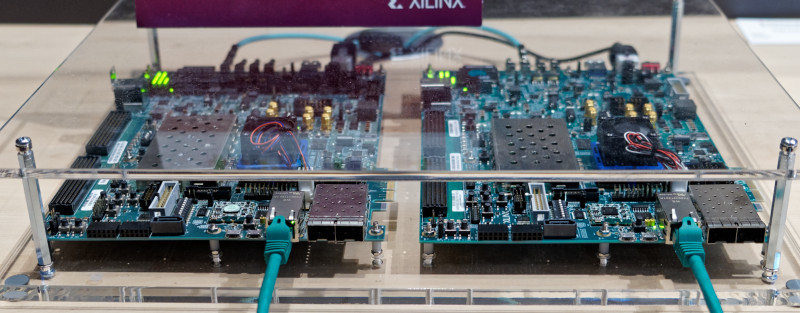 Omnitek was showning this Codec based on an Xilinx ASIC. Image:Meko
Omnitek was showning this Codec based on an Xilinx ASIC. Image:Meko
Zytronic, which develops special PCap touch displays using direct written sensors (making it ideal for low volume and custom touch designs) from 5″ up to 90″, was showing its latest ZXY500 controller which is a new custom ASIC that has faster rise times and higher voltages, so it has better SNR than other designs. The better SNR means that bezels can be smaller and touch sensors can be placed closer to display modules, reducing parallax issues. The company also believes that over time the new controller will allow lower prices. The company expects to start using the latest controller from the end of Q1 2018.

